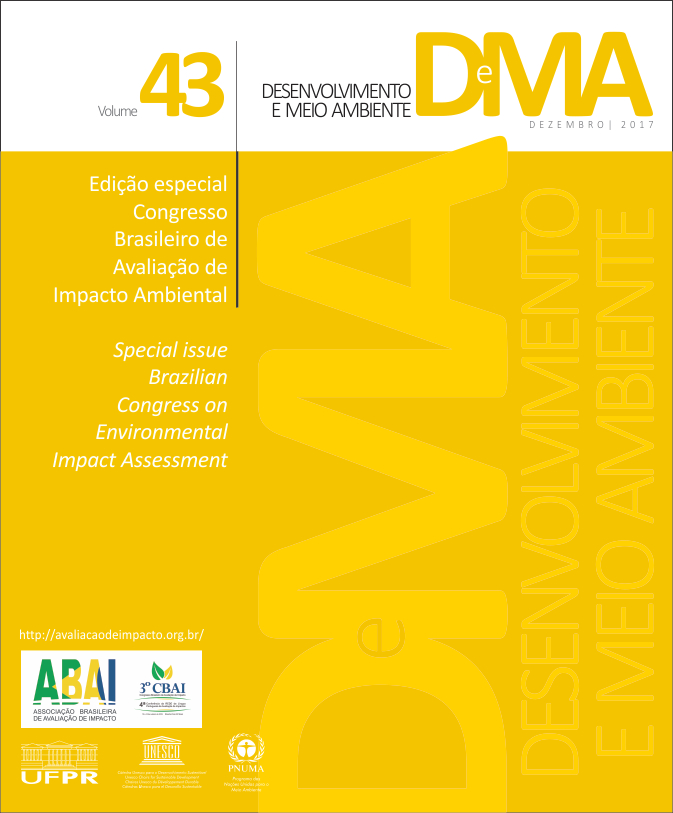Análise de serviços ecossistêmicos na avaliação de impacto ambiental: proposta e aplicação em um empreendimento minerário
DOI:
https://doi.org/10.5380/dma.v43i0.54106Palavras-chave:
serviços ecossistêmicos, avaliação de impactos ambientais, mineraçãoResumo
Considerando a inclusão da abordagem dos serviços ecossistêmicos na avaliação ambiental de empreendimentos, a partir de um estudo de caso em uma mineração de rocha fosfática, o presente estudo teve como objetivo responder a seguinte questão: quais impactos decorrentes da mineração mais interferem na oferta local de serviços ecossistêmicos? O método de análise utilizado foi fundamentado em um modelo de avaliação não monetária, com base nos padrões da atividade de mineração, bem como na capacidade das diferentes classes de uso e ocupação do solo em fornecer serviços ecossistêmicos. Dentre os 27 serviços potenciais a serem ofertados pela paisagem local, todos são afetados pelos impactos ambientais gerados pela mineração. A maior interferência ocorreu nos serviços diretamente relacionados ao bem-estar da população envolvida, que representam o provimento de recursos naturais e de informações e oportunidades, porém, no Estudo de Impacto Ambiental não estão descritas medidas mitigadoras ou programas sociais relacionados a estes serviços, o que demonstra que a abordagem empregada por este método de avaliação ambiental comumente utilizado não leva em consideração todos os aspectos relacionados ao bem-estar da população envolvida. Dentre os 32 impactos ambientais identificados, nove não interferiram no fornecimento de serviços ecossistêmicos e estes impactos estão relacionados a aspectos socioeconômicos, o que demonstra que o uso da abordagem de serviços ecossistêmicos na avaliação de impacto ambiental, com foco nos serviços potenciais ofertados localmente pela paisagem e sem levar em consideração a análise econômica da atividade, acaba por subdimensionar a interferência na esfera social e econômica. Recomenda-se inserir este método de análise na avaliação de impactos ambientais de empreendimentos e projetos, visto que esta ferramenta de avaliação baseada em serviços ecossistêmicos permite identificar conflitos e sinergias entre as atividades antrópicas e os ecossistemas, fornecendo subsídios para apontar medidas adicionais de mitigação de impactos e de compensação ambiental.
Downloads
Publicado
Como Citar
Edição
Seção
Licença
Os Direitos Autorais sobre trabalhos publicados nesta revista são do autor, com direitos de primeira publicação para a revista. O conteúdo dos trabalhos publicados é de inteira responsabilidade dos autores. A DMA é um periódico de acesso aberto (open access), e adota a licença Creative Commons Atribuição 4.0 Não Adaptada (CC-BY), desde janeiro de 2023. Portanto, ao serem publicados por esta Revista, os artigos são de livre uso para compartilhar (copiar e redistribuir o material em qualquer suporte ou formato para qualquer fim, mesmo que comercial) e adaptar (remixar, transformar, e criar a partir do material para qualquer fim, mesmo que comercial). É preciso dar o crédito apropriado, prover um link para a licença e indicar se mudanças foram feitas.
Os conteúdos publicados pela DMA do v. 53 de 2020 ao v. 60 de 2022 são protegidos pela licença Creative Commons Atribuição – Não Comercial – Sem Derivações 4.0 Internacional.
A DMA é uma revista de acesso aberto desde a sua criação, entretanto, do v.1 de 2000 ao v. 52 de 2019, o periódico não adotava uma licença Creative Commons e, portanto, o tipo de licença não é indicado na página inicial dos artigos.




